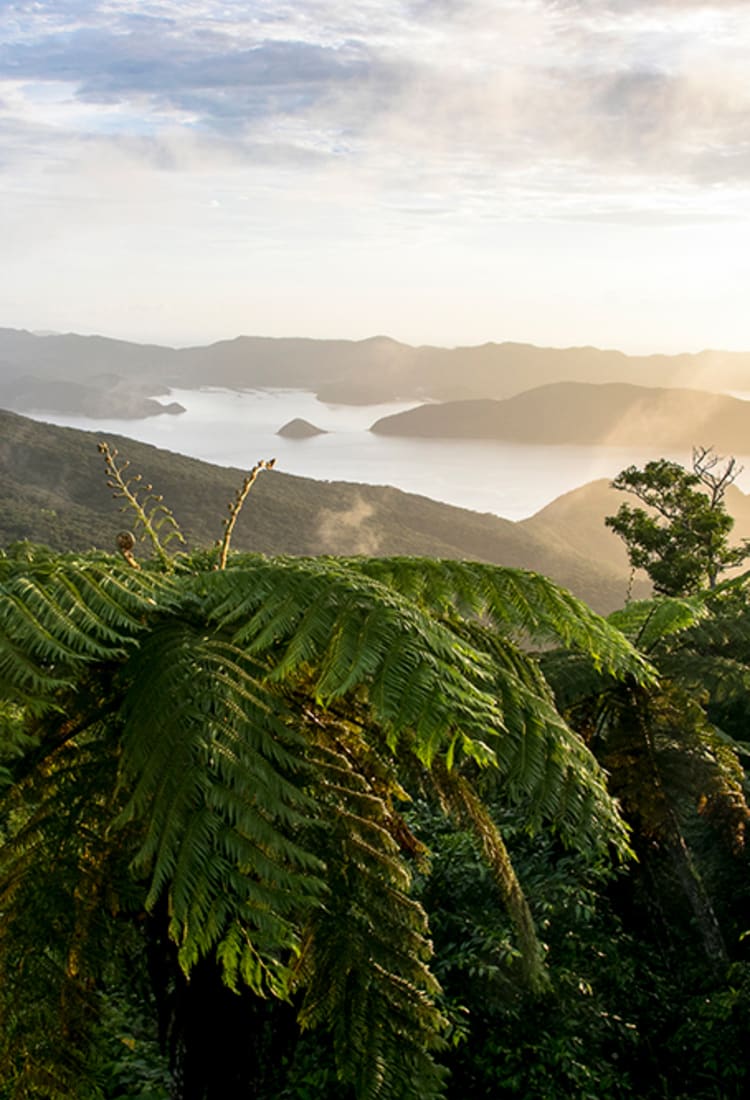
2020.08 Amami Oshima and Tokunoshima Islands—Important Sanctuaries for Rare Flora and Fauna
The rich biodiversity of Amami Oshima is a rare and precious resource
Amami Oshima is a remote island around a one-hour flight from Kagoshima Airport. Many centuries of isolation meant life evolved undisturbed as it adapted to the environment, resulting in species unique to the island. Today, the islands continue to support a diverse collection of flora and fauna including the Amami rabbit, the Amami Ishikawa’s frog and the Amami jay (Lidth’s jay).
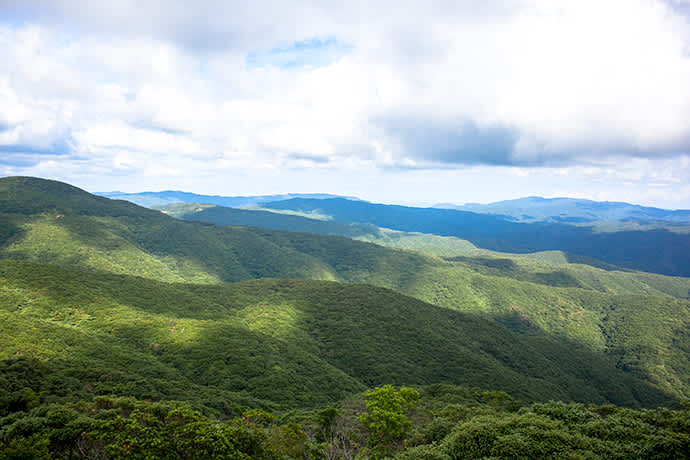
Mt. Yuwandake (694.4 meters; 2278 ft.) is the highest mountain on Amami Oshima
Amami Oshima’s inland terrain varies from pastoral in the north to rugged in the southern and central areas where mountain forest covers 90 percent of the landscape. Heavy rainfall throughout the year (3,000 millimeters; 118 in.) feeds the subtropical evergreen trees and ferns in the forests that, in turn, support many other forms of life. Similarly, the island’s beaches sustain the lifecycles of sea turtles who come to lay their eggs in coves along the shore, and around 220 species of coral live in the warm ocean currents off the island’s coast.
The Sumiyo mangroves—saltwater survivors and protectors of rare wildlife
Amami Oshima’s terrain includes more than just forest and ocean. A vast, untouched mangrove forest spanning around 0.7 square kilometers (7.5 sq. ft.) dominates the landscape in the town of Sumiyo in the southeastern part of the island. Mangrove is the generic name for trees and plants that have evolved to survive in a saltwater environment. In Sumiyo, seawater from the Pacific Ocean flows up the Sumiyo and Yakagachi rivers at high tide flooding the plain. The Sumiyo mangrove forest is located at the spot where the two rivers meet.
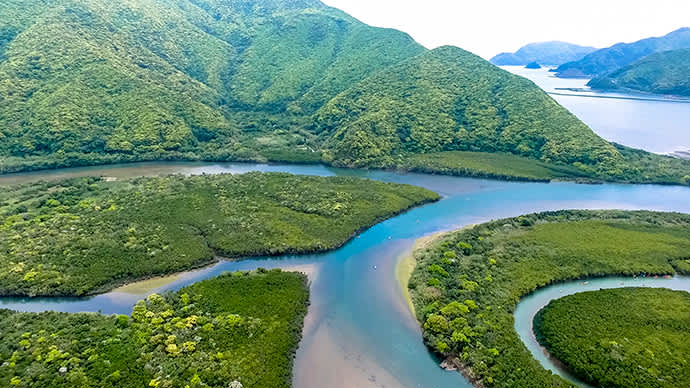
The mangrove forests at Sumiyo at the point where two rivers meet
Roots are vital to a mangrove’s survival. Mangrove roots can differ aesthetically depending on the species, but they generally perform the same functions: keeping the tree upright in the shifting muddy ground, filtering out salt and taking in oxygen from the atmosphere (because the earth in which mangroves live is oxygen-poor). The two prevalent species of mangrove in Sumiyo are ohirugi (Bruguiera gymnorhiza) and mehirugi (Kandelia obovata).
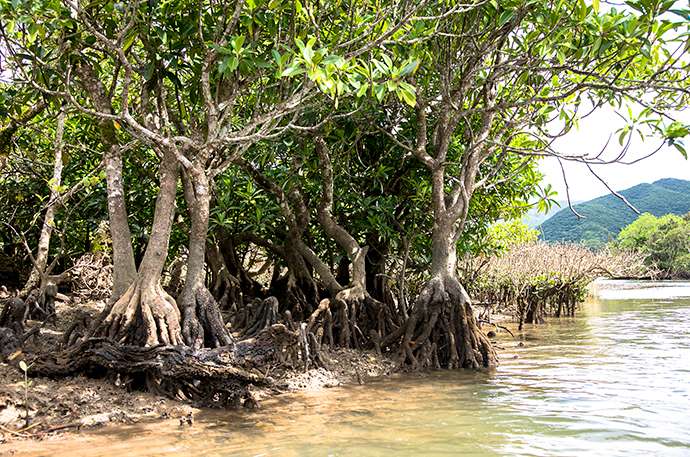
The “knee roots” of ohirugi mangrove trees
The ohirugi mangroves in Sumiyo have “knee roots,” named for their resemblance to knobbly human knees. In contrast, the aerial roots of the mehirugi mangroves, called “buttress roots,” are shaped like thin boards that protrude from the trunk.
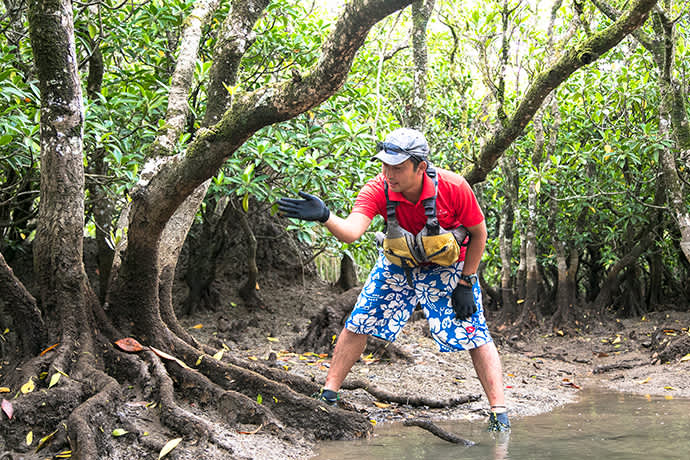
The sturdy buttress roots of the mehirugi mangrove
Mangrove roots play another role beyond that of the mangrove tree’s own survival. They protect species of wildlife that live in the waterways. On Amami Oshima, this role is particularly important for conservation because the species which the roots shelter are rare, and in some cases, unique to the island. The Ryukyu ayu fish is one such fish that can only be found on Amami Oshima, and its young hide in the mangroves’ aerial roots to protect themselves from birds and larger fish.
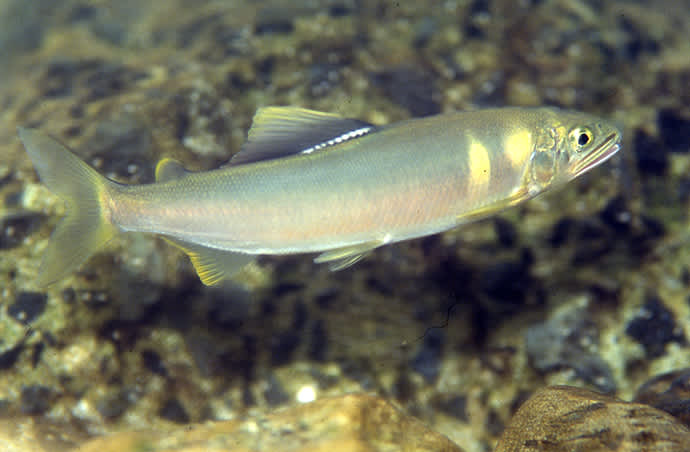
The Ryukyu ayu fish can only be found on Amami Oshima. Photo credit: Kuroshio no Mori Mangrove Park
Explore the mangrove forest in a canoe
A canoe experience on the mangrove forest waterways allows visitors to view the mangroves, their diverse root structures, and the wildlife that lives in the trees and among the roots. The Kuroshio no Mori Mangrove Park provides English-language canoe tours of the mangroves.
Shusaku Takahashi, an environmental researcher on Amami Oshima and a professional guide at the Mangrove Park, explains how visitors can enjoy different experiences as the tide moves in and out. “At high tide, you can wind through tunnels of mangroves, while low tide offers a chance to observe the crabs and other small creatures that make their homes in the tidal pools.”
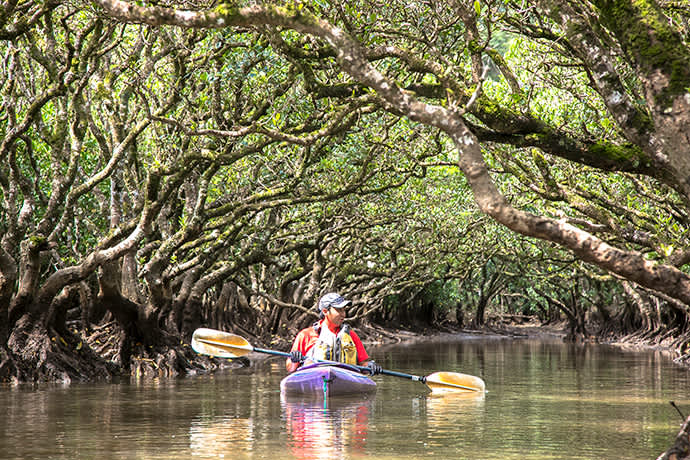
English-language tours through the mangroves are offered at the Kuroshio no Mori Mangrove Park
Barred mudskippers are one such creature that canoeists might see in the tidal pools. They are amphibious creatures that breathe through gills as well as through their skin. On land, they use pectoral fins to walk in a crawling motion. When surprised or startled, they propel themselves into the air with their tail.
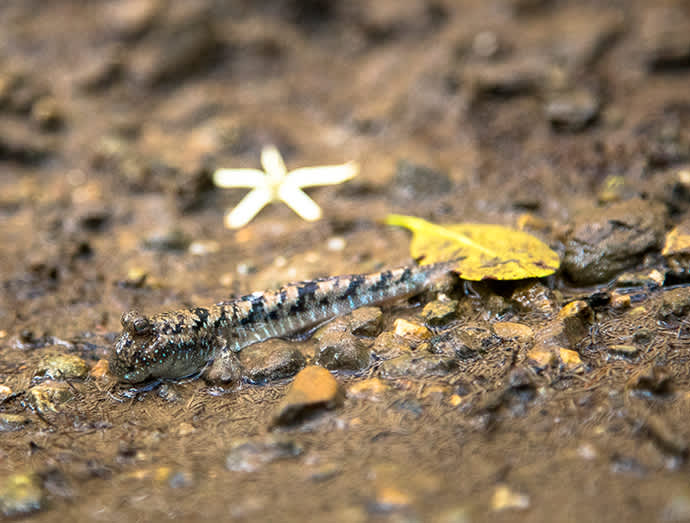
The amphibious barred mudskipper lives in Amami Oshima’s mangrove forests
The barred mudskipper shares the tidal pools with a large number of crabs, many with distinctive features. Fiddler crabs live in the mangroves, and their males have one giant claw that they brandish to attract females or use as a tool during combat.
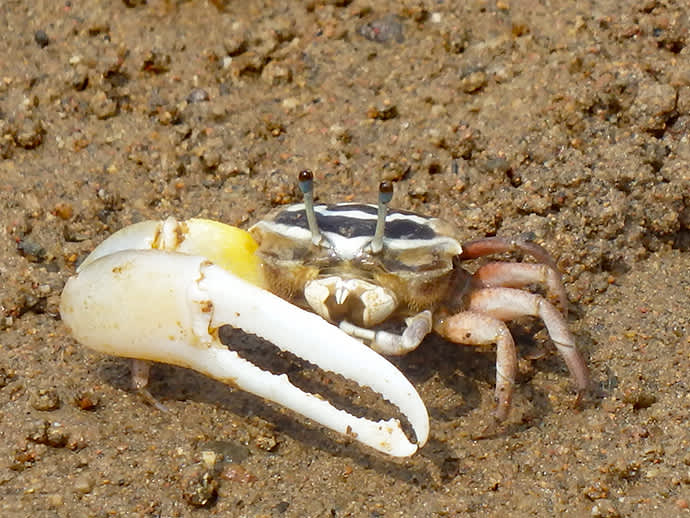
A male fiddler crab in the Amami Oshima mangrove forest. Photo credit: Kuroshio no Mori Mangrove Park
Purple mud crabs are another species of crab that live in the waterways of the mangrove forest. It is a large crab species with two massive purple claws. The crabs feed on clams and shellfish that they crush with their powerful pincers. Canoeists will need a keen eye to spot these crabs because are rarely seen when humans are around.
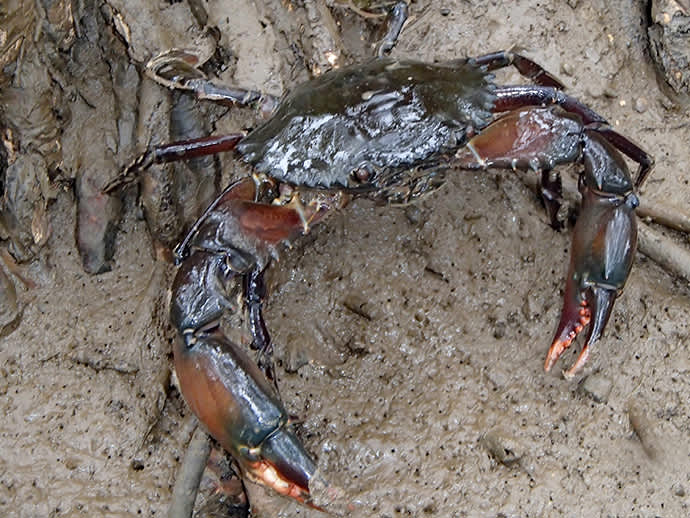
The shells of purple mud crabs grow to around 20 centimeters (8 in.) across. Photo credit: Kuroshio no Mori Mangrove Park
The Mictyris brevidactylus species of crab might be easier to spot due to its distinctive colorings—a light-blue upper section and red markings on its legs—and the fact that is walks in a straight line. Mud lobsters live in deep burrows under the mangroves. This act of burrowing helps maintain the health of the mangroves by bringing organic matter to the surface. The nutrient-packed matter helps support the ecosystem.
The Amami Oshima forests at night—an opportunity to view some rare animal species
Many of Amami Oshima’s native animal species are nocturnal. Guided nighttime forest tours run by the Kuroshio no Mori Mangrove Park offer visitors the chance to spot rare species that only come out at night. During a tour, professional guides drive visitors slowly and quietly through the forest, pointing out the wildlife.
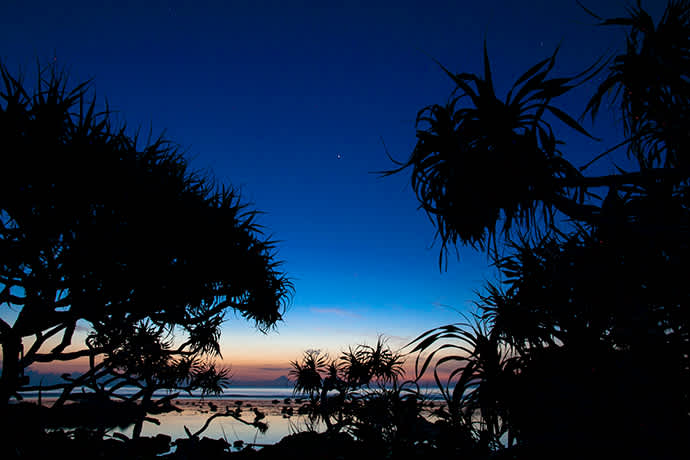
Discover Amami Oshima’s native nocturnal animals on a nighttime tour
Masataka Kawauchi is a nighttime guide skilled in tracking nocturnal wild animals. He relies on clues such as sounds and vibrations to find animals in the dark forest.
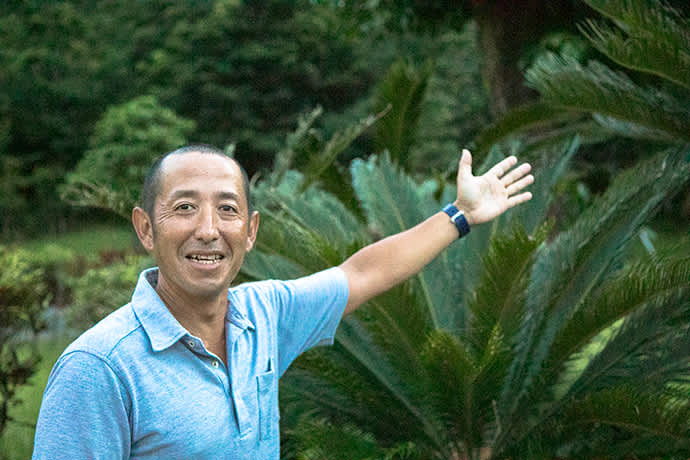
Professional guide Masataka Kawauchi
Spotting the Amami rabbit—an endemic species that only lives on Amami Oshima and Tokunoshima—is a highlight of a nighttime tour. “They often make their dens in the banks along the roadside and come out after dark to forage,” Masataka explained. The species is so rare that it was designated a Special Natural Monument in Japan, a title given to natural property (including animals, plants, minerals and geographical features) with a high scientific value.
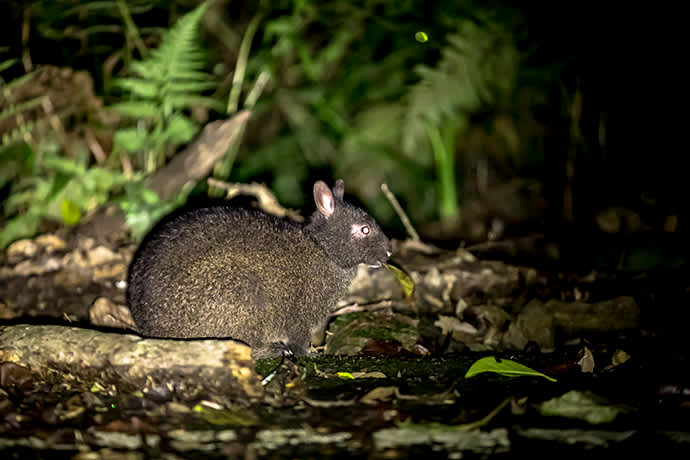
The Amami rabbit can only be found on Amami Oshima and Tokunoshima islands
Bird calls enable the nighttime guides to educate visitors on what is active in the Amami Oshima forests after dark. The Ryukyu scops-owl is one such bird that may be encountered during a tour. The small owl is difficult to see—especially in the dark—due to its natural camouflage. However, its distinctive call makes guides and tour participants aware of its presence. The Amami Oshima forests are vital for the bird’s survival, as the species is becoming increasingly rare due to loss of habitat.
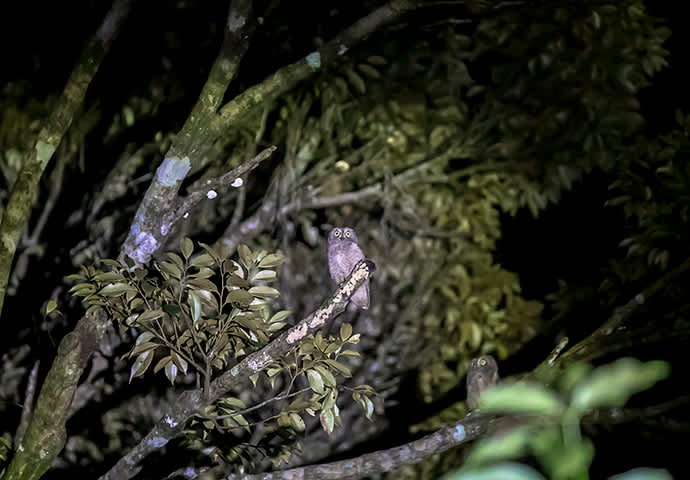
The Ryukyu scops-owl—a small owl that lives throughout the Ryukyu Islands
Amami spiny rats are native to Amami Oshima, and a potential sighting on a night tour. Like the Ryukyu scops-owl, these small, agile rodents face threats from habitat destruction and the introduction of alien species. Therefore, the Amami Oshima forests are essential for the rats’ survival.
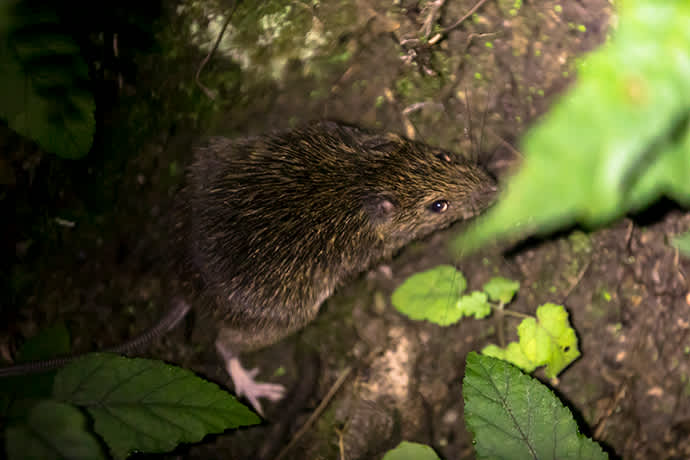
The Amami spiny rat is native to Amami Oshima
Another rare endemic species that may make an appearance is the Amami Ishikawa’s frog. The frog has a metallic sheen with a golden spotted pattern across its back and is only found on Amami Oshima island.
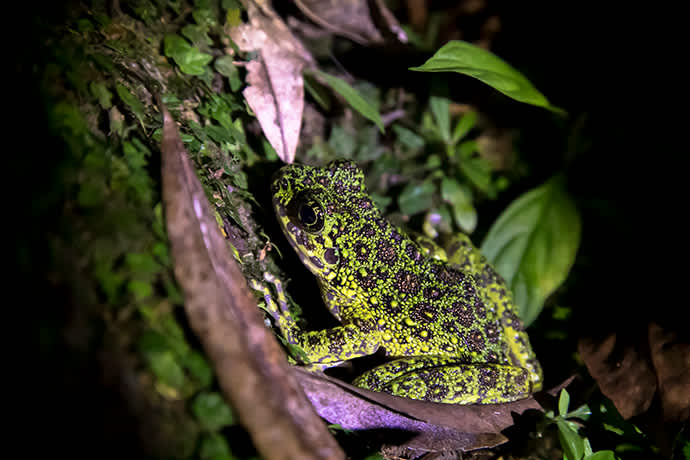
The Amami Ishikawa’s frog is a native species found only on Amami Oshima island
Frogs thrive on Amami Oshima thanks to the island’s abundant insect population, which they use as a food source. Other frog species present on Amami Oshima include the Otton frog and the Amami tip-nosed frog.
Island cultural heritage inspired by the natural environment
Amami Oshima is one of a group of islands that make up the Amamigunto National Park. The Japanese government granted the area national park status in 2017 due to its unspoiled natural beauty, rare ecosystems, and history of interplay between humans and the natural environment. Conservation is essential in maintaining this precious habitat and efforts have increased further following the national park designation. Local communities hope that achieving a place on UNESCO’s coveted World Heritage Site list will boost the profile and protection of the area even further.
Nature and traditional crafts
The long history of interaction between locals and their natural environment is represented through Amami Oshima’s traditional crafts. The island’s signature craft is Oshima tsumugi, a fabric dyed using native plants and mud, with designs inspired by local leaf patterns. The material was once primarily used to make kimono but has now been extended to other fabric accessories.
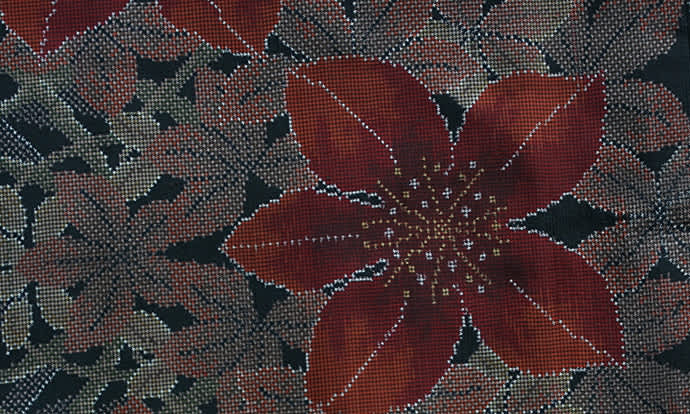
Oshima tsumugi is one of Amami Oshima's traditional crafts
Local culinary culture
Amami Oshima food culture is inspired by what is grown and available locally. Keihan (literally, “chicken rice”) is essentially chicken and vegetables piled on rice, but a topping of island fruits such as pickled papaya or tankan citrus peel give it a distinctive flavor and appearance.
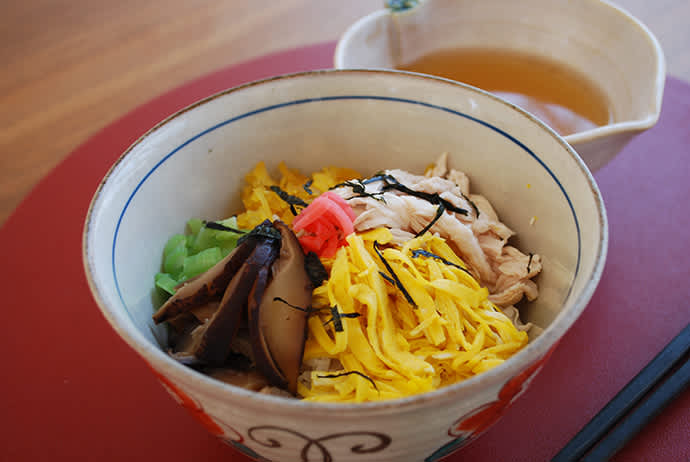
Keihan—a homecooked dish using local ingredients
Tokunoshima—a tranquil island with distinctive flora, fauna and geology
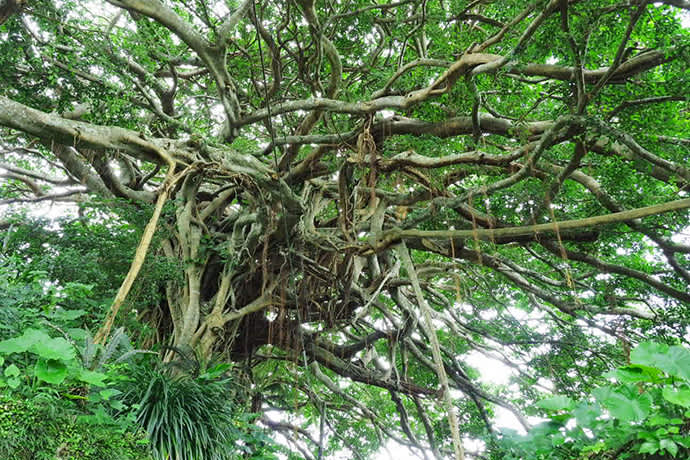
Chinese banyan trees grow in Tokunoshima Island villages. Photo credit: Yuilander Tokunoshima
Tokunoshima Island shares a similar history with the larger Amami Oshima. Tokunoshima, a 35-minute flight from Amami Oshima, was isolated for millions of years, leaving flora and fauna on the island to evolve without outside interference. Today, the island supports many rare and protected species, including the Ryukyu robin and the Tokunoshima spiny rat.
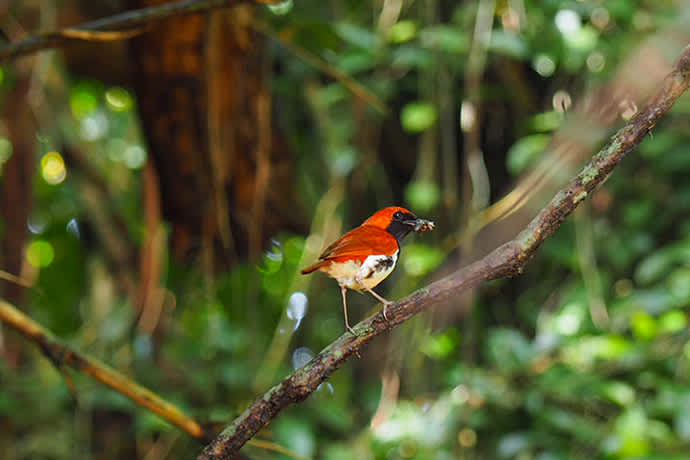
The Ryukyu robin on Tokunoshima Island. Photo credit: Yuilander Tokunoshima
The northern and central parts of the island are dominated by mountains and forests that provide a habitat for a wealth of wild species. In contrast, the western and southern areas are made up of gently sloping plateaus suitable for farming. The primary crop of Tokunoshima is sugarcane.
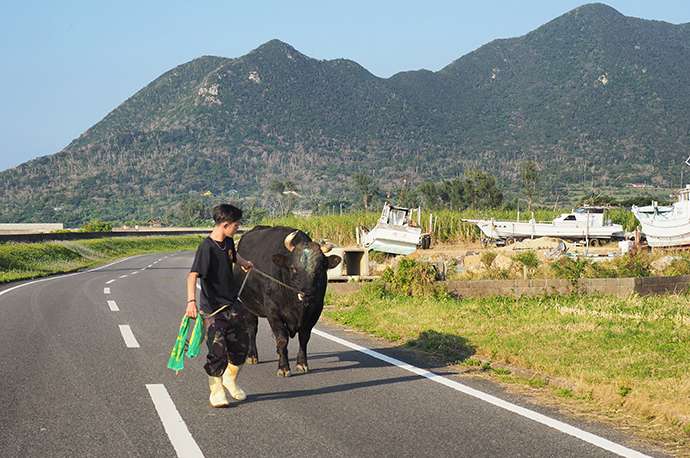
Bullfighting has been a part of Tokunoshima culture for centuries. Photo credit: Yuilander Tokunoshima
Three-hundred-year-old Chinese banyan trees provide protection
Booking a professional guided tour of the island is a good way for visitors to learn more about the island’s rich nature, culture, and heritage. Yukiyo Fukumoto is an English-speaking guide who runs a variety of customized tours, including one centered around Chinese banyan. These large trees have taken root all over the island, with some dating back over 300 years.
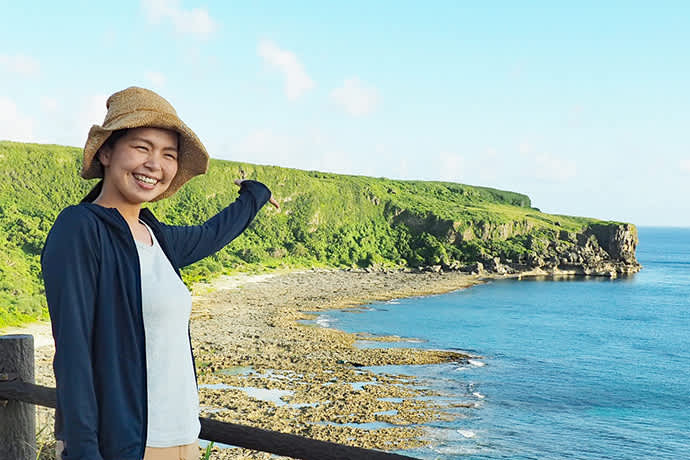
Professional guide Yukiyo Fukumoto offers custom tours of Tokunoshima. Photo credit: Yuilander Tokunoshima
Yukiyo’s Chinese banyan tour takes visitors to Agon, a hamlet in the southwestern part of the island. The Chinese banyans here are thought to be over 300 years old, with leaves and branches spanning 30–40 meters (100-130 ft.). The trees are planted close to the iconic limestone walls that ring the traditional-style houses because Chinese banyans act as windbreaks that protect residents from the frequent typhoons.
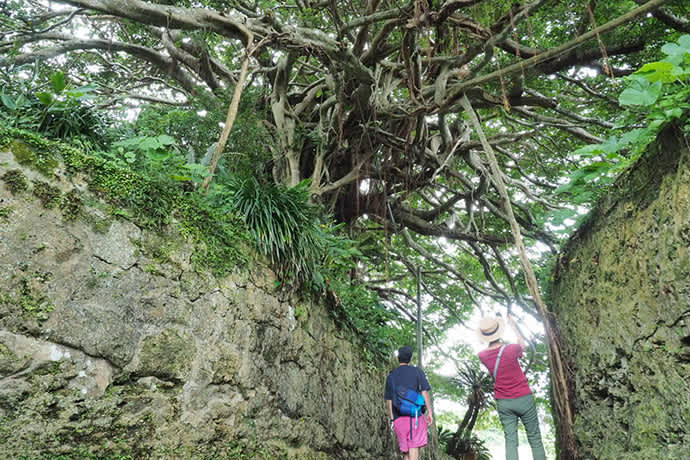
A Chinese banyan grows atop a stone wall (the tree is located on private property and inaccessible to visitors). Photo credit: Yuilander Tokunoshima
Tours visit other remarkable natural and geological features of Tokunoshima including Shikaura Gorge, located about a 10-minute walk from Agon. Over many years, the area has been carved into a V-shape by river, rain and wind action. A bridge that spans the valley grants picturesque views of the dramatic scenery.
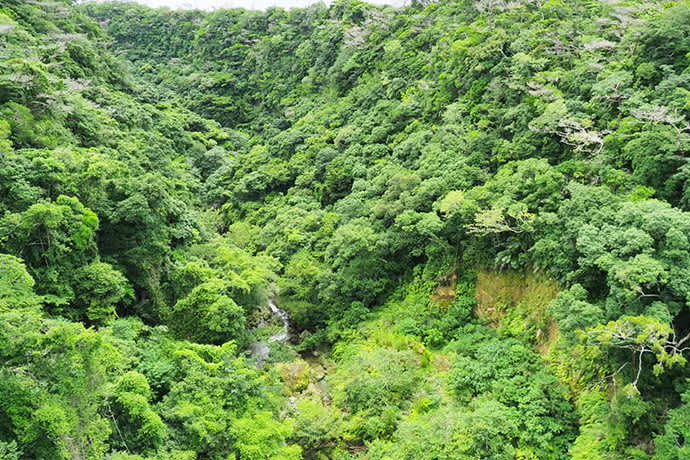
Laurel forests cover Shikaura Gorge. Photo credit: Yuilander Tokunoshima
Yukiyo details the calls of birds and insects that are found in and around the gorge in summer. She highlights a cicada that makes a dinging noise like a bell, along with the ruddy kingfisher—a scarlet migratory bird, sometimes called a firebird—that makes a distinctive call.
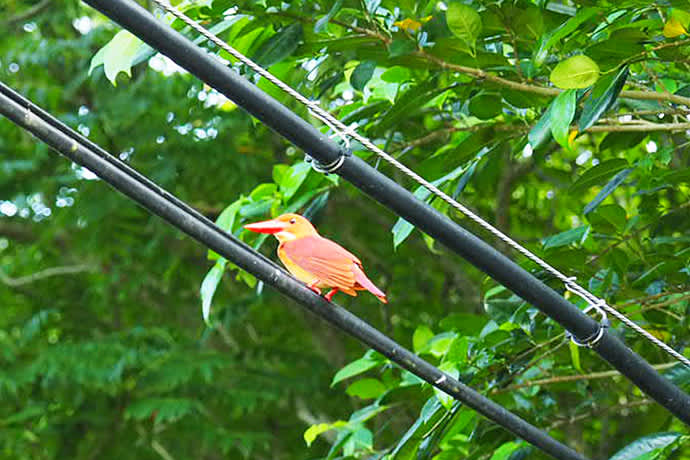
The ruddy kingfisher is a migratory bird that residents see as a harbinger of summer. Photo credit: Yuilander Tokunoshima
The landscape of Tokunoshima includes many distinct and noteworthy geological formations. Centuries of changing sea levels and erosion by wind and waves have created various striking landforms.
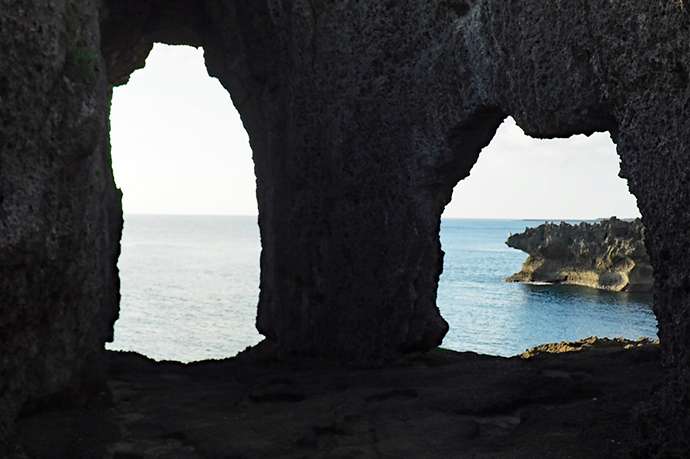
An unusual Ryukyu limestone formation at In no Jobuta. Photo credit: Yuilander Tokunoshima
In no Jobuta is a coastal spot on the island's west side, a 30-minute drive from Shibaura Gorge. The Ryukyu limestone cliffs here have been naturally shaped into a formation resembling a pair of glasses.
Aiming to become one of Japan’s UNESCO World Heritage Sites
Amami Oshima and Tokunoshima are aiming to gain World Heritage Site designation from UNESCO, and increased conservation efforts of the island's precious ecosystems are a motivator to achieve this goal. A world heritage-designation would likely lead to greater protections, safeguarding the islands' rich biodiversity.
As of summer 2020, Japan has 23 World Heritage Sites. These spots showcase the country's history and nature. They range from Japan's most iconic mountain, Mt. Fuji, to the Hiroshima Peace Memorial and the historic monuments of ancient Nara.
Kuroshio no Mori Mangrove Park
|
Yuilander Tokunoshima
|
300-year-old Chinese banyan |
|
Address: 622 Agon, Isen-cho, Oshima-gun, Kagoshima Prefecture Note: Located on private property. No trespassing. |
View of Shikaura Gorge |
|
Address: Shikaura, Isen-cho, Oshima-gun, Kagoshima Prefecture Note: Near Arafukubashi Bridge |
In no Jobuta |
|
Address: Kaneku, Amagi-cho, Oshima-gun, Kagoshima Prefecture |
Amamigunto National Park |
|
WEB:https://www.env.go.jp/en/nature/nps/park/amami/index.html |
Information on Amami Oshima |
Information on Tokunoshima |




























































